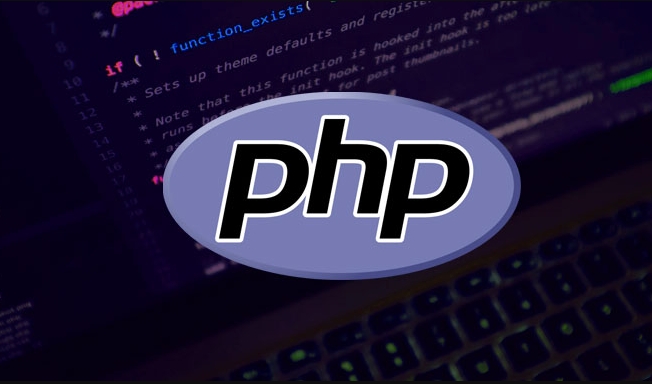PHP functions can improve code reusability and organization through function keyword definition. 1. Use function function name (parameter list) when defining a function { function body return return value; }, such as function add($a, $b) { return $a $b; }, the function name is case-sensitive, the parameters can have multiple or none, return is optional. 2. When calling a function, you must use the function name to add brackets and pass in the corresponding parameters, such as $result = add(3, 5); and the parameter order should be consistent with the definition, and brackets cannot be omitted. 3. You can set default parameters to enhance flexibility, such as function greet($name = "Guest") { echo "Hello, $name!"; }, which can be omitted when calling. 4. It is recommended to store functions in separate files and introduce them through include or require to avoid repeated definitions. You can use function_exists() to check whether they have been defined and the naming should be clear and clear.

It is actually not difficult to define and call a PHP function. As long as you understand the basic structure and syntax, you can get started quickly. Functions are the basic tools for organizing code and improving reusability. Whether writing small projects or large applications, they are inseparable from them.

1. How to define a function?
PHP uses the function keyword to define functions. The basic format is as follows:

function function name (parameter list) {
// Function body, that is, the executed code return return value; // optional}For example, define a simple addition function:
function add($a, $b) {
return $a $b;
}Some points to note:

- Function names are case-insensitive (but they are recommended to remain consistent)
- There can be multiple parameters or no
-
returnis an optional option to return the result
2. How to call a function?
After defining the function, you only need to use the function name to add brackets and pass in the corresponding parameters to call:
$result = add(3, 5); echo $result; // Output 8
Pay attention to when calling:
- The parameter order must be consistent with the definition
- If the parameter type is expected in the function, try to pass the correct type of data as much as possible
- Parentheses cannot be saved when calling a function without parameters
3. Use default parameters to make functions more flexible
Sometimes we want certain parameters to have default values ??so that they can be optionally omitted when called. For example:
function greet($name = "Guest") {
echo "Hello, $name!";
}The call method can be:
greet(); // Output Hello, Guest!
greet("Alice"); // Output Hello, Alice!This design allows functions to adapt to more scenarios and reduces the chance of errors.
4. Where to put the function? Some practical suggestions
- Concentrate common functions into a file , such as
functions.php, and then introduce them throughincludeorrequire. - Avoid repeatedly defining functions , otherwise an error will be reported. You can use
function_exists()to check whether it is defined. - Naming should be meaningful , for example,
calculateTotalPrice()is clearer thancalc().
Basically that's it. Functions are one of the most basic and practical structures in programming. If you write too much, you will find that it makes the code cleaner and the logic clearer.
The above is the detailed content of How to define and call a function in PHP?. For more information, please follow other related articles on the PHP Chinese website!

Hot AI Tools

Undress AI Tool
Undress images for free

Undresser.AI Undress
AI-powered app for creating realistic nude photos

AI Clothes Remover
Online AI tool for removing clothes from photos.

Clothoff.io
AI clothes remover

Video Face Swap
Swap faces in any video effortlessly with our completely free AI face swap tool!

Hot Article

Hot Tools

Notepad++7.3.1
Easy-to-use and free code editor

SublimeText3 Chinese version
Chinese version, very easy to use

Zend Studio 13.0.1
Powerful PHP integrated development environment

Dreamweaver CS6
Visual web development tools

SublimeText3 Mac version
God-level code editing software (SublimeText3)

Hot Topics
 What are some best practices for versioning a PHP-based API?
Jun 14, 2025 am 12:27 AM
What are some best practices for versioning a PHP-based API?
Jun 14, 2025 am 12:27 AM
ToversionaPHP-basedAPIeffectively,useURL-basedversioningforclarityandeaseofrouting,separateversionedcodetoavoidconflicts,deprecateoldversionswithclearcommunication,andconsidercustomheadersonlywhennecessary.StartbyplacingtheversionintheURL(e.g.,/api/v
 How do I implement authentication and authorization in PHP?
Jun 20, 2025 am 01:03 AM
How do I implement authentication and authorization in PHP?
Jun 20, 2025 am 01:03 AM
TosecurelyhandleauthenticationandauthorizationinPHP,followthesesteps:1.Alwayshashpasswordswithpassword_hash()andverifyusingpassword_verify(),usepreparedstatementstopreventSQLinjection,andstoreuserdatain$_SESSIONafterlogin.2.Implementrole-basedaccessc
 What are the differences between procedural and object-oriented programming paradigms in PHP?
Jun 14, 2025 am 12:25 AM
What are the differences between procedural and object-oriented programming paradigms in PHP?
Jun 14, 2025 am 12:25 AM
Proceduralandobject-orientedprogramming(OOP)inPHPdiffersignificantlyinstructure,reusability,anddatahandling.1.Proceduralprogrammingusesfunctionsorganizedsequentially,suitableforsmallscripts.2.OOPorganizescodeintoclassesandobjects,modelingreal-worlden
 What are weak references (WeakMap) in PHP, and when might they be useful?
Jun 14, 2025 am 12:25 AM
What are weak references (WeakMap) in PHP, and when might they be useful?
Jun 14, 2025 am 12:25 AM
PHPdoesnothaveabuilt-inWeakMapbutoffersWeakReferenceforsimilarfunctionality.1.WeakReferenceallowsholdingreferenceswithoutpreventinggarbagecollection.2.Itisusefulforcaching,eventlisteners,andmetadatawithoutaffectingobjectlifecycles.3.YoucansimulateaWe
 How can you handle file uploads securely in PHP?
Jun 19, 2025 am 01:05 AM
How can you handle file uploads securely in PHP?
Jun 19, 2025 am 01:05 AM
To safely handle file uploads in PHP, the core is to verify file types, rename files, and restrict permissions. 1. Use finfo_file() to check the real MIME type, and only specific types such as image/jpeg are allowed; 2. Use uniqid() to generate random file names and store them in non-Web root directory; 3. Limit file size through php.ini and HTML forms, and set directory permissions to 0755; 4. Use ClamAV to scan malware to enhance security. These steps effectively prevent security vulnerabilities and ensure that the file upload process is safe and reliable.
 What are the differences between == (loose comparison) and === (strict comparison) in PHP?
Jun 19, 2025 am 01:07 AM
What are the differences between == (loose comparison) and === (strict comparison) in PHP?
Jun 19, 2025 am 01:07 AM
In PHP, the main difference between == and == is the strictness of type checking. ==Type conversion will be performed before comparison, for example, 5=="5" returns true, and ===Request that the value and type are the same before true will be returned, for example, 5==="5" returns false. In usage scenarios, === is more secure and should be used first, and == is only used when type conversion is required.
 How can you interact with NoSQL databases (e.g., MongoDB, Redis) from PHP?
Jun 19, 2025 am 01:07 AM
How can you interact with NoSQL databases (e.g., MongoDB, Redis) from PHP?
Jun 19, 2025 am 01:07 AM
Yes, PHP can interact with NoSQL databases like MongoDB and Redis through specific extensions or libraries. First, use the MongoDBPHP driver (installed through PECL or Composer) to create client instances and operate databases and collections, supporting insertion, query, aggregation and other operations; second, use the Predis library or phpredis extension to connect to Redis, perform key-value settings and acquisitions, and recommend phpredis for high-performance scenarios, while Predis is convenient for rapid deployment; both are suitable for production environments and are well-documented.
 How do I perform arithmetic operations in PHP ( , -, *, /, %)?
Jun 19, 2025 pm 05:13 PM
How do I perform arithmetic operations in PHP ( , -, *, /, %)?
Jun 19, 2025 pm 05:13 PM
The methods of using basic mathematical operations in PHP are as follows: 1. Addition signs support integers and floating-point numbers, and can also be used for variables. String numbers will be automatically converted but not recommended to dependencies; 2. Subtraction signs use - signs, variables are the same, and type conversion is also applicable; 3. Multiplication signs use * signs, which are suitable for numbers and similar strings; 4. Division uses / signs, which need to avoid dividing by zero, and note that the result may be floating-point numbers; 5. Taking the modulus signs can be used to judge odd and even numbers, and when processing negative numbers, the remainder signs are consistent with the dividend. The key to using these operators correctly is to ensure that the data types are clear and the boundary situation is handled well.






